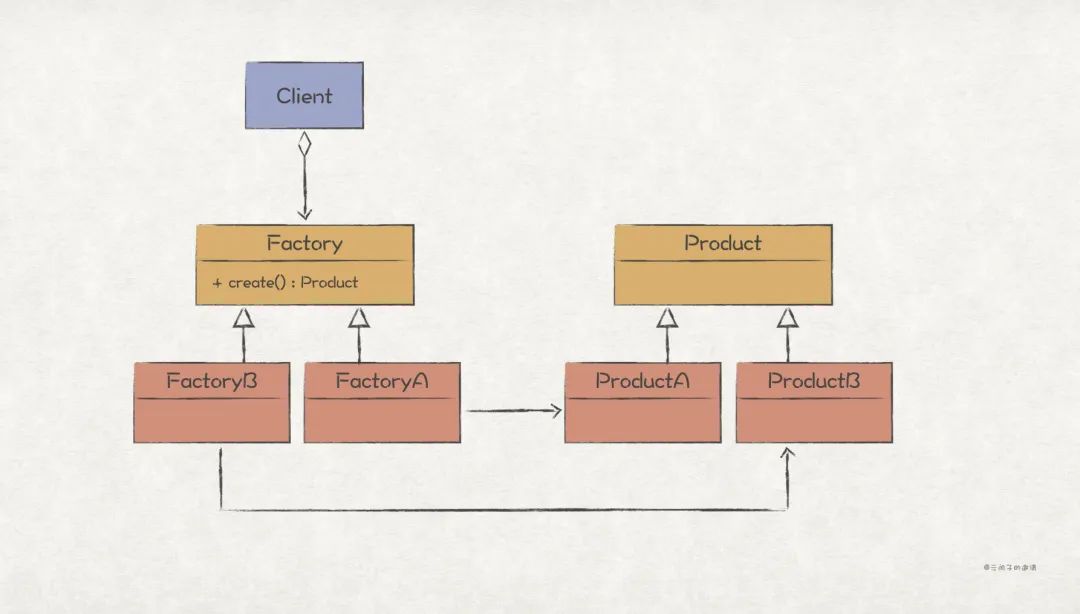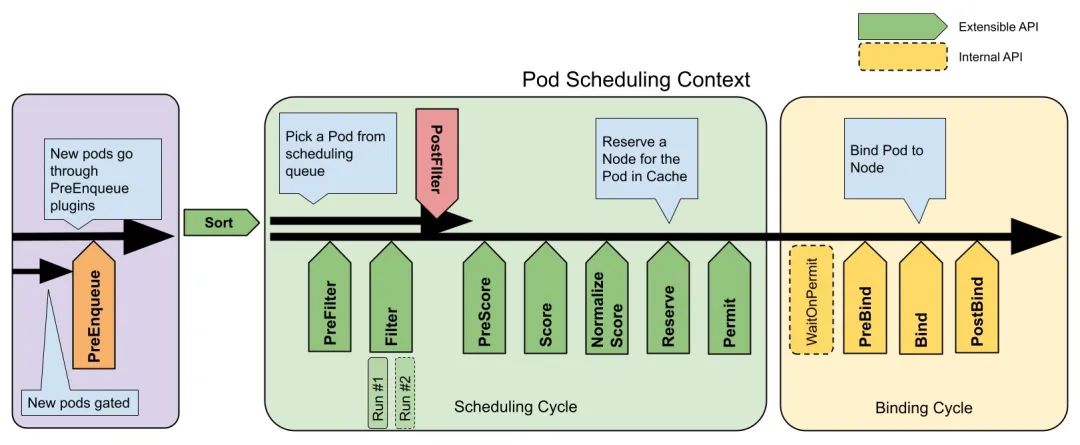工厂模式
工厂模式定义
工厂方法模式是一种创建型设计模式, 其在父类中提供一个创建对象的方法, 允许子类决定实例化对象的类型。
主要角色和UML类图
主要角色
抽象工厂模式主要包含4个角色:
抽象工厂(Factory):是工厂方法模式的核心,与应用程序无关。任何在模式中创建的对象的工厂类必须实现这个接口。
具体工厂(Concrete Factory):是实现抽象工厂接口的具体工厂类,包含与应用程序密切相关的逻辑,并且被应用程序调用以创建产品对象。
抽象产品(Product):是工厂方法模式所创建的对象的超类型,也就是产品对象的共同父类或共同拥有的接口。
具体产品(Concrete Product):这个角色实现了抽象产品角色所定义的接口。某具体产品有专门的具体工厂创建,它们之间往往一一对应。
UML类图

K8S调度器如何使用工厂模式
k8s的Framework是kubernetes扩展的第二种实现,主要是围绕着预选和优选阶段进行扩展,提供了更多的扩展点,其中每个扩展点都是一类插件,我们可以根据我们的需要在对应的阶段来进行扩展插件的编写,实现调度增强。主要的扩展点如下图所示:

插件思想可以通过工厂模式来实现,一个插件暴露出来的是一个工厂函数,由调用者或者插件架构来将提供配置信息传入,生成插件实例。k8s的调度器代码是通过插件工厂来存储所有注册的插件工厂,然后通过插件工厂构建具体的插件。
// 插件工厂注册表,用于存储所有注册的插件工厂
type Registry map[string]PluginFactory
// 向注册表注册一个插件工厂
func (r Registry) Register(name string, factory PluginFactory) error {
if _, ok := r[name]; ok {
return fmt.Errorf("a plugin named %v already exists", name)
}
r[name] = factory
return nil
}
定义PluginFactory工厂方法类型,工厂函数即传入对应的参数,构建一个Plugin,其中framework.Handle主要是用于获取快照和集群的其他数据。
type PluginFactory = func(configuration runtime.Object, f framework.Handle) (framework.Plugin, error)
函数NewInTreeRegistry()实现了InTree插件批量注册,根据插件名称初始化各插件函数保存到Registry注册表中。
func NewInTreeRegistry() runtime.Registry {
registry := runtime.Registry{
dynamicresources.Name: runtime.FactoryAdapter(fts, dynamicresources.New),
selectorspread.Name: selectorspread.New,
imagelocality.Name: imagelocality.New,
tainttoleration.Name: tainttoleration.New,
nodename.Name: nodename.New,
nodeports.Name: nodeports.New,
nodeaffinity.Name: nodeaffinity.New,
podtopologyspread.Name: runtime.FactoryAdapter(fts, podtopologyspread.New),
nodeunschedulable.Name: nodeunschedulable.New,
noderesources.Name: runtime.FactoryAdapter(fts, noderesources.NewFit),
noderesources.BalancedAllocationName: runtime.FactoryAdapter(fts, noderesources.NewBalancedAllocation),
volumebinding.Name: runtime.FactoryAdapter(fts, volumebinding.New),
volumerestrictions.Name: runtime.FactoryAdapter(fts, volumerestrictions.New),
volumezone.Name: volumezone.New,
nodevolumelimits.CSIName: runtime.FactoryAdapter(fts, nodevolumelimits.NewCSI),
nodevolumelimits.EBSName: runtime.FactoryAdapter(fts, nodevolumelimits.NewEBS),
nodevolumelimits.GCEPDName: runtime.FactoryAdapter(fts, nodevolumelimits.NewGCEPD),
nodevolumelimits.AzureDiskName: runtime.FactoryAdapter(fts, nodevolumelimits.NewAzureDisk),
nodevolumelimits.CinderName: runtime.FactoryAdapter(fts, nodevolumelimits.NewCinder),
interpodaffinity.Name: interpodaffinity.New,
queuesort.Name: queuesort.New,
defaultbinder.Name: defaultbinder.New,
defaultpreemption.Name: runtime.FactoryAdapter(fts, defaultpreemption.New),
schedulinggates.Name: runtime.FactoryAdapter(fts, schedulinggates.New),
}
return registry
}
拿NodeAffinity插件为例,该插件的初始化函数New的类型为PluginFactory,在函数NewInTreeRegistry()中会调用该初始化函数,将构建NodeAffinity插件的函数注册到Registry注册表中。
func New(plArgs runtime.Object, h framework.Handle) (framework.Plugin, error) {
args, err := getArgs(plArgs)
if err != nil {
return nil, err
}
pl := &NodeAffinity{
handle: h,
}
...
return pl, nil
}
以上就是工厂函数注册的全流程,那么Plugin又是何时初始化的呢?在profile(用来保存不同调度器的 framework 框架, framework 则用来存放 plugin)创建时,会初始化NewFramework,该函数调用生成的插件工厂注册表,来通过每个插件的Factory构建Plugin插件实例, 保存到pluginsMap中。
// NewFramework initializes plugins given the configuration and the registry.
func NewFramework(ctx context.Context, r Registry, profile *config.KubeSchedulerProfile, opts ...Option) (framework.Framework, error) {
options := defaultFrameworkOptions(ctx.Done())
for _, opt := range opts {
opt(&options)
}
f := &frameworkImpl{
registry: r,
snapshotSharedLister: options.snapshotSharedLister,
scorePluginWeight: make(map[string]int),
waitingPods: newWaitingPodsMap(),
clientSet: options.clientSet,
kubeConfig: options.kubeConfig,
eventRecorder: options.eventRecorder,
informerFactory: options.informerFactory,
metricsRecorder: options.metricsRecorder,
extenders: options.extenders,
PodNominator: options.podNominator,
parallelizer: options.parallelizer,
}
...
pluginsMap := make(map[string]framework.Plugin)
for name, factory := range r {
args := pluginConfig[name]
if args != nil {
outputProfile.PluginConfig = append(outputProfile.PluginConfig, config.PluginConfig{
Name: name,
Args: args,
})
}
// 调用PluginFactory函数对插件进行初始化,构建plugin
p, err := factory(args, f)
if err != nil {
return nil, fmt.Errorf("initializing plugin %q: %w", name, err)
}
pluginsMap[name] = p
f.fillEnqueueExtensions(p)
}
...
return f, nil
}
工厂模式使用场景
工厂方法模式主要适用于以下应用场景。
创建对象需要大量重复的代码。
客户端不依赖产品类实例如何被创建、实现等细节。
一个类通过其子类来指定创建哪个对象。
工厂模式优缺点
优点
- 避免创建者和具体产品之间的紧密耦合。
- 单一职责原则。 将产品创建代码放在程序的单一位置, 从而使得代码更容易维护。
- 开闭原则。 无需更改现有客户端代码, 就可以在程序中引入新的产品类型。
缺点
应用工厂方法模式需要引入许多新的子类, 代码可能会因此变得更复杂。 最好的情况是将该模式引入创建者类的现有层次结构中。
文档信息
- 本文作者:caitui
- 本文链接:https://caitui.github.io/2023/09/19/factory-pattern/
- 版权声明:自由转载-非商用-非衍生-保持署名(创意共享3.0许可证)
